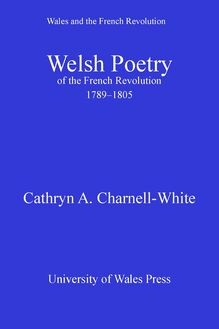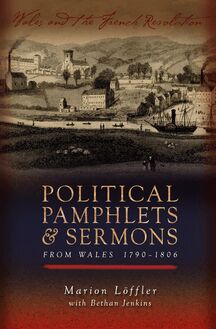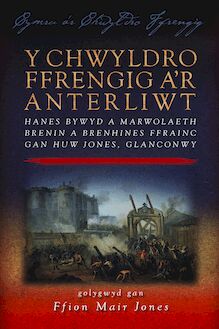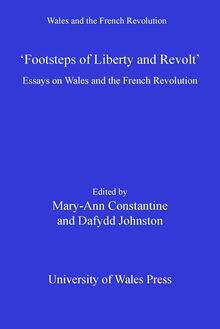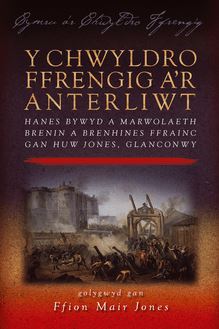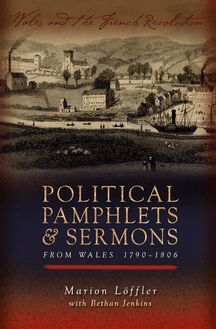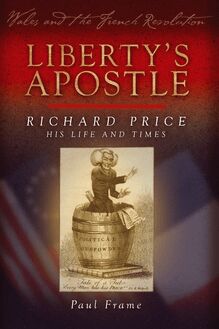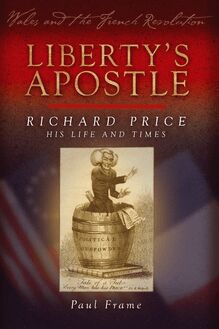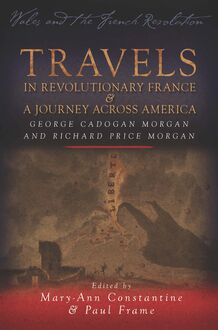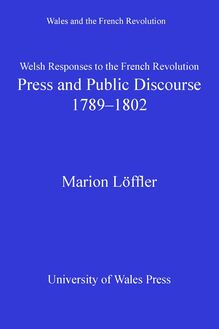Liberty's Apostle - Richard Price, His Life and Times , livre ebook
170
pages
English
Ebooks
2015
Vous pourrez modifier la taille du texte de cet ouvrage
Obtenez un accès à la bibliothèque pour le consulter en ligne En savoir plus
Découvre YouScribe en t'inscrivant gratuitement
Découvre YouScribe en t'inscrivant gratuitement
170
pages
English
Ebooks
2015
Vous pourrez modifier la taille du texte de cet ouvrage
Obtenez un accès à la bibliothèque pour le consulter en ligne En savoir plus
Publié par
Date de parution
20 mars 2015
Nombre de lectures
1
EAN13
9781783162185
Langue
English
Poids de l'ouvrage
7 Mo
Born in the village of Llangeinor, near Bridgend in south Wales, Richard Price (1723–91) was, to his contemporaries, an apostle of liberty, an enemy to tyranny and a great benefactor of the human race. His friend Benjamin Franklin described aspects of his work as ‘the foremost production of human understanding that this century has afforded us’. A supporter of the American and French Revolutions, Price corresponded with the likes of Jefferson, Adams, Washington, Mirabeau and Condorcet. In November 1789 he publicly welcomed the start of the French Revolution and thus inspired not only Edmund Burke to write his rebuttal in Reflections on the Revolution in France, but also the Revolution Controversy, ‘the most crucial ideological debate ever carried on in English’. Price also brought to world attention the Bayes-Price Theorem on probability, which is the invisible background to so much in modern life, and wrote a fundamental text on moral philosophy. Yet, despite all this and more, he remains little-known beyond academia, a situation that this biography helps to rectify. Liberty’s Apostle tells his life story through his published works and, fully for the first time, his now published correspondence with a host of eighteenth century celebrities. The life revealed is of a truly remarkable Welshman and, as Condorcet remarked, of ‘one of the formative minds’ of the eighteenth century Enlightenment.
Introduction: Rediscovering Richard Price
1 A Background of Dissent
2 A London Life
3 The Virtues of Virtue
4 The Equitable Life
5 Science and Society
6 Freedoms Denied
7 Price, Franklin and the Honest Whigs
8 On a Perilous Edge
9 Revolution In America
10 Reaction at Home and Abroad
11 Reform and Contribution at Home
12 Peace with America
13 Advising Ireland, Scotland and America
14 Pitt and the Sinking Fund
15 The Watershed Years
16 Revolution in France
17 On the Love of Our Country
18 Burke and his Reflections
19 The Close
Publié par
Date de parution
20 mars 2015
Nombre de lectures
1
EAN13
9781783162185
Langue
English
Poids de l'ouvrage
7 Mo
WALES AND THE FRENCH REVOLUTION
General Editors: Mary-Ann Constantine and Dafydd Johnston
Richard Price, D.D. F.R.S. , engraving by Thomas Holloway, 1793, after a painting by Benjamin West.
WALES AND THE FRENCH REVOLUTION
Liberty s Apostle Richard Price, his Life and Times
PAUL FRAME
Paul Frame, 2015
All rights reserved. No part of this book may be reproduced in any material form (including photocopying or storing it in any medium by electronic means and whether or not transiently or incidentally to some other use of this publication) without the written permission of the copyright owner except in accordance with the provisions of the Copyright, Designs and Patents Act 1988. Applications for the copyright owner s written permission to reproduce any part of this publication should be addressed to The University of Wales Press, 10 Columbus Walk, Brigantine Place, Cardiff CF10 4UP.
www.uwp.co.uk
British Library Cataloguing-in-Publication Data A catalogue record for this book is available from the British Library.
ISBN 978-1-78316-216-1 e-ISBN 978-1-78316-218-5
The right of Paul Frame to be identified as author of this work has been asserted by him in accordance with sections 77, 78 and 79 of the Copyright, Designs and Patents Act 1988.
Cover illustration : Detail from Annabal Scratch , Richard Price ( Tale of a Tub ) (1791), engraving. National Portrait Gallery, London.
For my brother Jonathan and to the memory of our parents Gwen and Geoff Frame
WALES AND THE FRENCH REVOLUTION
The French Revolution of 1789 was perhaps the defining event of the Romantic period in Europe. It unsettled not only the ordering of society but language and thought itself: its effects were profoundly cultural, and they were long-lasting. The last twenty years have radically altered our understanding of the impact of the Revolution and its aftermath on British culture. In literature, as critical attention has shifted from a handful of major poets to the non-canonical edges, we can now see how the works of women writers, self-educated authors, radical pamphleteers, prophets and loyalist propagandists both shaped and were shaped by the language and ideas of the period. Yet surprising gaps remain, and even recent studies of the British reaction to the Revolution remain poorly informed about responses from the regions. In literary and historical discussions of the so-called four nations of Britain, Wales has been virtually invisible; many researchers working in this period are unaware of the kinds of sources available for comparative study.
The Wales and the French Revolution Series is the product of a four-year project funded by the AHRC and the University of Wales at the Centre for Advanced Welsh and Celtic Studies. It makes available a wide range of Welsh material from the decades spanning the Revolution and the subsequent wars with France. Each volume, edited by an expert in the field, presents a collection of texts (including, where relevant, translations) from a particular genre with a critical essay situating the material in its historical and literary context. A great deal of material is published here for the first time, and all kinds of genres are explored. From ballads and pamphlets to personal letters and prize-winning poems, essays, journals, sermons, songs and satires, the range of texts covered by this series is a stimulating reflection of the political and cultural complexity of the time. We hope these volumes will encourage scholars and students of Welsh history and literature to rediscover this fascinating period, and will offer ample comparative scope for those working further afield.
Mary-Ann Constantine and Dafydd Johnston
General Editors
Theologian, philosopher, mathematician;
Friend to Freedom as to Virtue;
Brother of Man;
Lover of Truth as of God;
His eminent talents were matched by his integrity,
Simplicity, and goodness of heart;
His moral dignity by his profound humility.
Few have been more useful in their generation,
Or more valued by the wise and good;
None more pure and disinterested.
Honoured be his name!
Imitated his example!
Inscription on Richard Price s memorial in
Newington Green chapel, London.
Give me Dr. Price s political principles and I will move all kings out of their thrones, and all subjection out of the world.
John William Fletcher, American Patriotism Further
Confronted with Reason, Scripture and the Constitution:
Being Observations on the Dangerous Politicks Taught
by the Rev. Mr. Evans and the Rev. Dr. Price. With a
Scriptural Plea for the Revolted Colonies (Shrewsbury, 1776).
Contents
List of Figures and Plates
Preface
Acknowledgements
List of Abbreviations
Introduction: Rediscovering Richard Price
1. A Background of Dissent
2. A London Life
3. The Virtues of Virtue
4. The Equitable Life
5. Science and Society
6. Freedoms Denied
7. Price, Franklin and the Club of Honest Whigs
8. On a Perilous Edge
9. Revolution in America
10. Reaction at Home and Abroad
11. Reform and Contribution at Home
12. Peace with America
13. Advising Ireland, Scotland and America
14. Pitt and the Sinking Fund
15. The Watershed Years (1786-8)
16. Revolution in France
17. On the Love of our Country
18. Burke and his Reflections
19. The Close
Notes
Select Bibliography
Figures and Plates
Frontispiece
Richard Price, D.D. F.R.S. , engraving by Thomas Holloway, 1793, after a painting by Benjamin West
Fig. 1
Tynton, the Price family home at Llangeinor, south Wales
Fig. 2
Memorial to Richard Price s paternal grandparents in Bettws church, south Wales
Fig. 3
Stoke Newington Church, 1750 , unattributed engraving in Walter Thornbury, Old and New London (London, n.d.)
Fig. 4
Price s home in Newington Green
Fig. 5a
Newington Green Chapel in 1860 , unattributed photograph
Fig. 5b
Newington Green chapel today
Fig. 6
Title page of A Review of the Principal Questions and Difficulties in Morals (1758; 3rd edn., London, 1787)
Fig. 7
Richard Price s certificate of election to the Royal Society, December 1765
Fig. 8
The Bayes-Price theorem on probabilities
Fig. 9
William Morgan , engraving by William Say, 1803, after a painting by George Hounsom
Fig. 10
Title page of Observations on Reversionary Payments (1771; 4th edn., London, 1783)
Fig. 11
Watkin Lewes Esqr Presenting the Addresses from the Counties of Pembroke, Carmarthen, and Cardigan, to the Lord Mayor, Alderman Wilkes, and Alderman Oliver in the Tower , unattributed engraving
Fig. 12
The Royal Society s House in Crane Court , unattributed engraving in Walter Thornbury, Old and New London (London, n.d.)
Fig. 13
Title page of Observations on the Nature of Civil Liberty (1776; 3rd edn., London, 1776)
Fig. 14
Declaration of Independence, July 4th 1776 , engraving by Asher Brown Durand after a painting by John Trumbull
Fig. 15
Edmund Burke, Esq.r by J. Chapman sculp , 1798, and published by J. Wilkes
Fig. 16
The Politician (Benjamin Franklin), engraving by J. Ryder, 1782, after a painting by Stephen Elmer
Fig. 17
Title page of Observations on the Importance of the American Revolution and the Means of Making It a Benefit to the World (London, 1784)
Fig. 18
The Right Honourable William Pitt , drawn by L. Jackson and engraved by H. Meyer, 1810, after a painting by I. Hoppner
Fig. 19
Letter from Richard Price to his wife Sarah
Fig. 20
Mirabeau L Ain (Honor Gabriel Riquetti, Comte de Mirabeau), engraved by Jacques-Louis Copia, c .1791, after a painting by Louis-Marie Sicardi
Fig. 21
The Marquis de Lafayette Presiding over the French National Assembly, 13-14th July 1789 , unattributed French engraving, c .1830
Fig. 22
Title page of A Discourse on the Love of our Country (London, 1790)
Fig. 23
Price s tomb in Bunhill Fields cemetery, City of London
Fig. 24
Details from Richard Price memorial railings, Llangeinor, south Wales
Plate 1a
Richard Price, D.D. F.R.S. by Benjamin West, 1784
Plate 1b
Benjamin Franklin , 1783, after Joseph Duplessis
Plate 2a
Joseph Priestley by Ellen Sharples, c. 1797
Plate 2b
William Petty, 1st Marquis of Lansdowne (Lord Shelburne) , 1766, after Sir Joshua Reynolds
Plate 3a
Mary Wollstonecraft by John Opie, 1797
Plate 3b
John Horne Tooke by Thomas Hardy, before 1791
Plate 4a
Smelling out a rat; or the atheistical-revolutionist disturbed in his midnight calculations attributed to James Gillray, 1790
Plate 4b
The doctor indulged with his favourite scene by Isaac Cruikshank, December 1790(?)
Preface
In his preface to The Honest Mind: The Thought and Work of Richard Price , the late D. O. Thomas warned that the most intrepid biographer faced a daunting prospect and herculean task in trying to do justice to all the details of Price s achievements. The question of whether I have done them justice or not I am happy to leave to the judgement of the reader, but the herculean nature of the task has been made far less daunting thanks to the diligent scholarship and wide-ranging nature of David Thomas s own publications on Price. 1 To these, and in particular the three volumes of Price s collected correspondence which Thomas edited with Bernard Peach, I owe the greatest debt. Shortly before he died David told me that one reviewer of these volumes had criticized them for the number and detail of the footnotes they contain. I am simply thankful for them.
Mention must also be made of David s wife, Beryl Thomas, who in deciphering Price s private shorthand journal has provided this and any future biographer with a rare insight into Price s deeper personality and character; something generally hidden in his correspondence and published works. My profound thanks also go to Martin Fitzpatrick for his interest in the project, for his reading of the text a number of times over many years, and for useful comments shared during enjoyable meetings in Aberystwyth and at his home in

